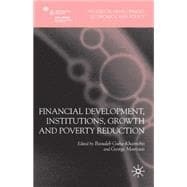
| List of Tables and Figures | p. ix |
| Acknowledgements | p. xiii |
| Notes on the Contributors | p. xiv |
| List of Abbreviations | p. xviii |
| Introduction and Overview | p. 1 |
| Sources and Effectiveness of Financial Development: What We Know and What We Need to Know | p. 10 |
| Introduction | p. 10 |
| Sources of financial development | p. 11 |
| Sources of financial development: some new evidence | p. 23 |
| Effectiveness of financial development | p. 27 |
| Summary and conclusion | p. 34 |
| The Poverty-Macroeconomic Policy Nexus: Some Short-Run Analytics | p. 38 |
| Background and motivation | p. 38 |
| Sketch of the model | p. 41 |
| Equilibrium | p. 45 |
| Variations in parameters | p. 46 |
| Conclusion and policy implications | p. 54 |
| Finance and Poverty in Ethiopia: A Household-Level Analysis | p. 61 |
| Introduction | p. 61 |
| Finance and poverty | p. 63 |
| Poverty, savings and access to credit in Ethiopia | p. 64 |
| Theoretical framework and estimation results: finance and poverty | p. 70 |
| Conclusion | p. 83 |
| Financial Sector Development, Savings Mobilization and Poverty Reduction in Ghana | p. 87 |
| Introduction | p. 87 |
| Developments in Ghana's financial sector | p. 89 |
| Financial sector development and poverty reduction | p. 95 |
| Methods of analysis | p. 102 |
| Findings | p. 103 |
| Conclusion and policy implications | p. 114 |
| Appendix | p. 116 |
| Finance and Growth: An Empirical Assessment of the Indian Economy | p. 120 |
| Introduction | p. 120 |
| Financial development and transmission mechanism | p. 122 |
| Empirical results | p. 125 |
| Conclusion | p. 135 |
| Does Financial Openness Promote Economic Integration? | p. 141 |
| Introduction | p. 141 |
| Theoretical background | p. 143 |
| Methodology and data | p. 145 |
| Econometric results | p. 149 |
| Conclusion and directions of future research | p. 157 |
| Descriptions of variables | p. 159 |
| Does Financial Liberalization Influence Saving, Investment and Economic Growth? Evidence From 25 Emerging Market Economies, 1973-96 | p. 164 |
| Introduction | p. 164 |
| Financial liberalization and economic growth: a brief review of the existing literature | p. 165 |
| Data and methodology | p. 171 |
| Regression results | p. 177 |
| Conclusion | p. 183 |
| Data sources | p. 184 |
| The Corporate Debt Market in India: An Analytical Study of Macroeconomic and Institutional Issues | p. 190 |
| Introduction and brief literature review | p. 190 |
| Data, model and results | p. 197 |
| Conclusion | p. 207 |
| Financial Markets and R&D Investments: A Discrete Time Model to Interpret Public Policies | p. 212 |
| Introduction | p. 212 |
| The model | p. 215 |
| A slightly unusual result: what is the role of financial markets? | p. 222 |
| Interpretation of the results and policy considerations | p. 226 |
| Financial Sector Development and Total Factor Productivity Growth | p. 231 |
| Introduction | p. 231 |
| Production function approach | p. 233 |
| Data issues | p. 239 |
| Estimation and results | p. 243 |
| Conclusion | p. 255 |
| The Effects of Regional Integration: Impact on Real Effective Exchange Rate Volatility, Institutional Quality and Growth for MENA Countries | p. 260 |
| Introduction | p. 260 |
| Cost of volatility and advantage of flexibility: theoretical rationales and empirical findings | p. 261 |
| The literature on exchange rate volatility, institutional quality and growth | p. 263 |
| Methodology | p. 264 |
| Specification for conditional convergence growth model | p. 266 |
| Empirical findings | p. 268 |
| Conclusion and policy implications for MENA countries | p. 279 |
| Appendix | p. 281 |
| Index | p. 287 |
| Table of Contents provided by Ingram. All Rights Reserved. |
The New copy of this book will include any supplemental materials advertised. Please check the title of the book to determine if it should include any access cards, study guides, lab manuals, CDs, etc.
The Used, Rental and eBook copies of this book are not guaranteed to include any supplemental materials. Typically, only the book itself is included. This is true even if the title states it includes any access cards, study guides, lab manuals, CDs, etc.